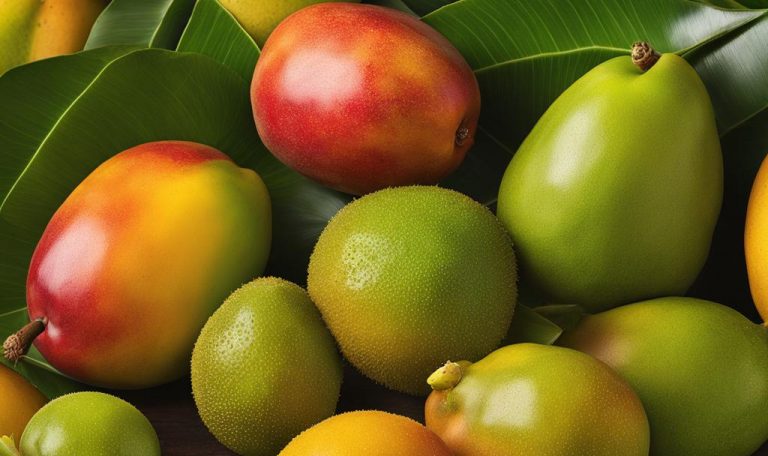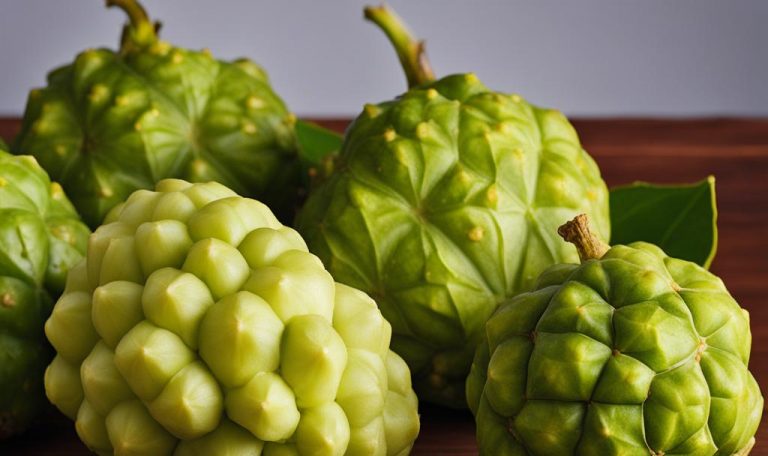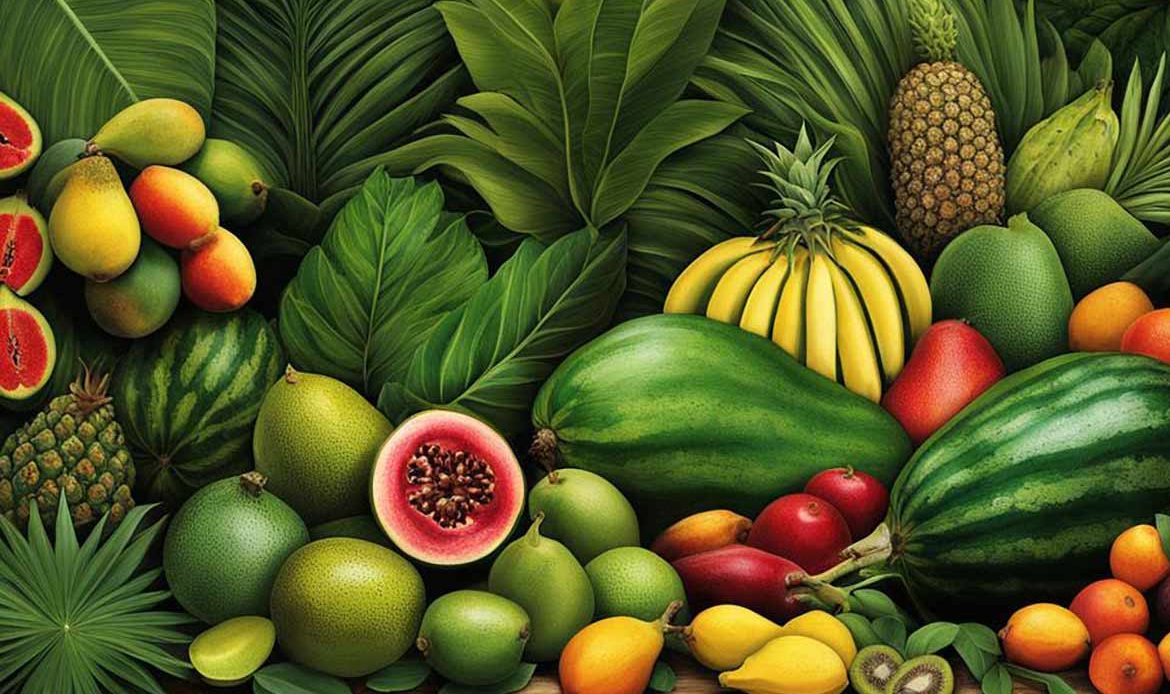Welcome to our tropical fruit adventure! In this article, we’ll take you on a journey to discover the exotic fruits that thrive in the tropical paradises of Costa Rica and Panama. From vibrant flavors to unique aromas, these fruits are a true delight for your taste buds. Whether you’re looking for a refreshing snack or a healthy addition to your meals, these tropical fruits have got you covered.
Get ready to explore the diverse selection of tropical fruits that can be found in Costa Rica and Panama. From the abundance of exotic fruits in Panama to the flavorful tropical delights of Costa Rica, we’ll dive into the unique characteristics and health benefits of each fruit.
Key Takeaways:
- Costa Rica and Panama are known for their diverse and delicious tropical fruits.
- These fruits offer unique tastes and fresh aromas, making them a sought-after choice for fruit enthusiasts.
- Exploring tropical fruits from Costa Rica and Panama allows us to appreciate the wonders of nature and discover the health benefits they have to offer.
- Whether you’re looking to buy exotic fruits online or experience the flavors firsthand, these tropical fruits are worth exploring.
- Stay tuned as we delve deeper into the tropical fruit havens of Costa Rica and Panama in the following sections.
Panama’s Abundance of Exotic Fruits
Panama, with its diverse landscapes and climate, is home to a wide variety of exotic fruits that are not only enjoyed locally but also exported to other countries. The tropical fruit farming industry plays a significant role in Panama’s economy, with many farmers dedicated to cultivating these flavorful gems.
Some of the popular Panamanian fruits include:
- Aguacate (Avocado): Known for its creamy texture and rich flavor, Panama’s avocados are highly sought after.
- Banana: As one of the largest banana exporters, Panama produces high-quality bananas enjoyed both domestically and internationally.
- Guanabana (Soursop): This spiky green fruit is known for its distinct flavor and is often used to make refreshing juices and desserts.
- Mamon Chino (Rambutan): With its hairy red skin and juicy flesh, the rambutan is a tropical delight that is popular in Panama.
- Marañon (Cashew Fruit): While the cashew nut is well-known, the cashew fruit is a tropical gem with a sweet and tangy taste.
These fruits are not only enjoyed for their unique flavors but also for their nutritional benefits. Panama’s tropical fruit farming industry continues to thrive, ensuring a steady supply of these delicious fruits for both locals and international markets.
Costa Rica’s Flavorful Tropical Delights
Costa Rica is renowned for its rich biodiversity, and this extends to its tropical fruits. The country offers a wide array of flavorful tropical delights such as guanabana, mango, mangosteen, tamarindo, and tomate de arbol (tree tomato). These fruits can be enjoyed fresh, and some are also used in juices, smoothies, and desserts. With the availability of tropical fruit delivery services, people can easily enjoy the fresh taste of Costa Rican fruits even outside of the country.
One of the most popular tropical fruits in Costa Rica is guanabana, also known as soursop. It has a unique flavor that is both sweet and tart, with a hint of acidity. The fruit’s flesh is custard-like and white, with big black seeds. Guanabana can be eaten raw, used for juicing, or added to smoothies. It is also a popular ingredient in tropical fruit juices.
Mango is another beloved tropical fruit that thrives in Costa Rica. It is known for its aromatic, sweet, and juicy flesh. There are various varieties of mangoes available in the country, each with its own unique taste. Mangoes can be enjoyed fresh or used in various recipes such as chutneys, jellies, and juices. The versatility of mangoes makes them a favorite ingredient in tropical fruit recipes.
The Health Benefits of Costa Rican Fruits
In addition to their delightful flavors, Costa Rican fruits offer numerous health benefits. Guanabana is rich in fiber, vitamins C and B, and antioxidants. It is believed to have antimicrobial and anti-inflammatory properties. Mangoes are packed with vitamins A and C, as well as dietary fiber. They are known to promote digestion and boost the immune system. Other fruits like mangosteen and tamarindo are also known for their high nutritional value and potential health benefits.
| Tropical Fruit | Health Benefits |
|---|---|
| Guanabana (soursop) | Antioxidant-rich, supports digestion, may have antimicrobial properties |
| Mango | Boosts immune system, promotes digestion, rich in vitamins A and C |
| Mangosteen | High in antioxidants, anti-inflammatory properties, supports cardiovascular health |
| Tamarindo (tamarind) | Rich in vitamins and minerals, aids digestion, may lower cholesterol levels |
Whether enjoyed for their delicious flavors or their potential health benefits, Costa Rican fruits offer a tropical taste experience like no other. The availability of tropical fruit delivery services makes it easier than ever to indulge in the fresh and vibrant flavors of these delightful fruits.
The Unique Taste of Guanabana
Guanabana, also known as soursop, is a tropical fruit that captivates the taste buds with its unique flavor profile. Its taste is a delightful combination of sweet and tart, with a slight hint of acidity that adds a refreshing zing. The fruit’s flesh is creamy and custard-like, with a smooth texture that melts in your mouth. Guanabana stands out among the tropical fruits of Costa Rica and Panama for its distinct taste and versatility.
One of the most popular ways to enjoy guanabana is by consuming it fresh. Simply cut open the fruit, remove the large black seeds, and scoop out the creamy flesh. Its rich flavor can be savored as is, or it can be used to create delicious tropical fruit juices and smoothies. Guanabana’s unique taste also makes it a great addition to ice creams, sorbets, and desserts.
In addition to its delectable flavor, guanabana offers numerous health benefits. It is rich in antioxidants, vitamins, and minerals, making it a nutritious choice for supporting overall well-being. This tropical fruit is known for its potential anti-inflammatory and immune-boosting properties. Guanabana also contains fiber, which aids in digestion and helps maintain a healthy gut. Incorporating guanabana into your diet can be a delicious way to enhance your health.
| Nutritional Content of Guanabana |
|---|
| Vitamin C |
| Vitamin B1 |
| Vitamin B2 |
| Potassium |
| Fiber |
“Guanabana’s unique flavor is like no other tropical fruit. Its creamy texture and refreshing taste make it a true tropical gem.”
When it comes to tropical fruit exploration, guanabana is a must-try. Its distinctive taste, creamy flesh, and nutritional benefits make it an irresistible choice. Whether enjoyed fresh, in juices, or incorporated into delightful desserts, guanabana offers a unique and fulfilling taste experience. Discover the wonders of guanabana and indulge in the flavors of Costa Rica and Panama’s tropical paradise.
Guanabana
Mango: A Versatile Tropical Fruit for Delicious Recipes
Mango is a beloved tropical fruit that is widely enjoyed for its rich flavor and versatility in culinary creations. With its aromatic, sweet, and juicy flesh, mango adds a delightful tropical twist to a variety of dishes. Whether eaten fresh or used in recipes, mangoes are a favorite ingredient among food enthusiasts.
One popular way to enjoy mango is in refreshing smoothies and fruit salads. The vibrant color and tropical taste of mango lend themselves perfectly to these chilled treats. Try blending ripe mango with yogurt, ice, and a splash of coconut water for a creamy and indulgent smoothie. Alternatively, toss diced mango with other tropical fruits like papaya and pineapple for a vibrant fruit salad bursting with flavor.
Another delicious use for mango is in savory dishes. Its natural sweetness can balance out the heat and spice in dishes like mango salsa or chutney. Mango salsa, made with diced mango, red onion, cilantro, lime juice, and a touch of chili pepper, pairs perfectly with grilled fish or chicken. Mango chutney, cooked with spices like ginger, mustard seeds, and vinegar, adds a flavorful kick to curries or sandwiches.
Benefits of Mango
- Rich in vitamins A and C, which support a healthy immune system.
- Contains dietary fiber, aiding in digestion and promoting a healthy gut.
- Provides antioxidants that help protect against cell damage and reduce inflammation.
- Supplies potassium, an essential mineral for heart health and fluid balance in the body.
Whether enjoyed on its own or incorporated into various recipes, mangoes bring a taste of the tropics to your plate. Don’t miss out on this versatile fruit and indulge in the delicious flavors it has to offer.

| Recipe | Ingredients | Instructions |
|---|---|---|
| Mango Smoothie |
|
|
| Mango Salsa |
|
|
| Mango Chutney |
|
|
The Peculiar Rambutan
Native to Indonesia and Malaysia, mamon chino, also known as rambutan, is a peculiar-looking fruit with its red skin and spine-like protrusions. This exotic fruit has also made its way to Panama, where it is considered the national fruit, and can be found in other Caribbean countries like Jamaica. The rambutan’s outer appearance may be intriguing, but it is what’s inside that truly delights the taste buds.
The rambutan features juicy white flesh that is sweet and has a slight tanginess. Each fruit contains a large edible seed in the middle that adds a nutty flavor to the overall experience. The rambutan can be enjoyed on its own, simply by peeling off the skin, or it can be used in various culinary creations, including jellies, jams, cocktails, and syrups. Its unique taste and texture make it a fascinating addition to any tropical fruit enthusiast’s repertoire.
The Joy of Jamaican Fruits
In addition to its presence in Panama, the rambutan can also be found in Jamaica. The vibrant and diverse culture of Jamaica is reflected in its delightful array of fruits. Alongside the rambutan, Jamaican fruits such as ackee, guava, mango, and tamarind offer a rich tapestry of flavors and textures. These fruits are not only enjoyed on their own but are also used in traditional Jamaican dishes, such as ackee and saltfish or mango chow. Exploring the tropical fruits of Jamaica is a journey of discovery and a celebration of the unique flavors this Caribbean island has to offer.
Table: Comparing Mamon Chino and Rambutan
| Mamon Chino (Rambutan) | Origin | Appearance | Taste |
|---|---|---|---|
| Indonesia, Malaysia | Spine-like protrusions covering red skin | Juicy, sweet, with a hint of tanginess | |
| Panama, Jamaica | Large edible seed in the middle | Can be eaten on its own or used in various culinary creations |
When comparing mamon chino and rambutan, it is evident that they share many similarities in terms of taste and appearance. Both fruits offer a unique sensory experience, combining sweetness with a touch of tartness. Whether you come across mamon chino in Panama or rambutan in Jamaica, indulging in these tropical treats is sure to bring joy and excitement to your taste buds.
The Delightful Dragon Fruit
Dragon fruit, also known as pitahaya, is a visually stunning tropical fruit that not only looks exquisite but also offers a delightful taste. With its vibrant pinkish-red skin and green scales, dragon fruit is as beautiful as it is nutritious. Rich in fiber and antioxidants, it is a healthy choice for those looking to incorporate more tropical fruits into their diet.
The flesh of dragon fruit is sweet and juicy, with a subtle hint of refreshing tartness. The tiny seeds embedded in the flesh can also be consumed, adding a slight crunch to every bite. Dragon fruit can be enjoyed fresh by simply slicing it or scooping out the flesh with a spoon. Its unique flavor and beautiful appearance make it a popular ingredient in tropical fruit salads and smoothies, adding a burst of color and taste to these refreshing treats.
“Dragon fruit is not only visually appealing but also offers numerous health benefits. It helps support digestion, boosts the immune system, and promotes healthy skin. Plus, its low calorie and high fiber content make it a great addition to a balanced diet.”
So, the next time you come across a dragon fruit, don’t hesitate to give it a try. Whether you enjoy it fresh, add it to a tropical fruit salad, or blend it into a refreshing smoothie, this delightful fruit is sure to satisfy your taste buds and provide a burst of tropical goodness.
| Dragon Fruit Nutrition Facts | Per 100g |
|---|---|
| Calories | 60 |
| Carbohydrates | 9g |
| Fiber | 1g |
| Sugar | 8g |
| Protein | 1g |
| Fat | 0g |
| Vitamin C | 20% of the Daily Value (DV) |
| Calcium | 1% DV |
| Potassium | 3% DV |
Costa Rica’s Tropical Gems – Mangosteen
When it comes to tropical fruits, Costa Rica is a treasure trove of flavors and health benefits. Among these tropical gems is the exquisite mangosteen. With its round shape and red-purple skin, the mangosteen is visually captivating. But it’s the sweet, juicy white flesh inside that truly steals the show.
Mangosteen is not only a delicious fruit but also a nutritional powerhouse. Packed with vitamins C, B1, and B2, as well as essential minerals like potassium and calcium, it offers a range of health benefits. From boosting the immune system to supporting heart health, mangosteen is a fruit worth savoring.
Known for its delicate flavor, mangosteen is best enjoyed fresh. With each bite, you’ll experience a burst of sweetness that lingers on the palate. Its unique taste and nutritional profile make mangosteen a tropical gem that should not be missed.
So next time you’re in Costa Rica or have the opportunity to try mangosteen, indulge in this tropical delight and savor its exquisite taste and numerous health benefits.
Tasting the Unusual Noni Fruit
The noni fruit, also known as the “vomit fruit” or “cheese fruit,” is an intriguing tropical fruit with a distinct smell and bitter taste. Despite its unconventional characteristics, noni fruit is believed to have numerous health benefits, making it a popular choice in traditional medicine. This small fruit, native to Peru, Southeast Asia, and Latin America, has been used for centuries to address a wide range of ailments, from allergies to cancer.
The noni fruit is packed with essential nutrients and bioactive compounds that contribute to its therapeutic properties. It is rich in antioxidants, which help combat free radicals and reduce oxidative stress in the body. Additionally, noni fruit contains anti-inflammatory compounds that may help alleviate inflammation and associated health conditions.
While the pungent aroma and bitter taste may be off-putting to some, the health benefits of noni fruit make it worth a try. Many people choose to incorporate noni fruit into their diet by mixing it with other fruits in juices or smoothies. This allows them to enjoy the potential health benefits of noni fruit while masking its unique flavor. Whether you’re an adventurous eater or a health enthusiast, consider adding noni fruit to your tropical fruit repertoire to experience its potential health-promoting effects.
| Fruit | Taste | Health Benefits |
|---|---|---|
| Guanabana (Soursop) | Sweet and tart with a hint of acidity | Rich in antioxidants, may have anti-cancer properties |
| Mango | Aromatic, sweet, and juicy | High in vitamins A and C, supports eye health and boosts immunity |
| Rambutan (Mamon Chino) | Sweet and juicy | Contains iron and vitamin C, supports healthy blood circulation and immune system |
| Dragon Fruit (Pitahaya) | Sweet with a subtle flavor | High in fiber and antioxidants, promotes digestion and skin health |
| Mangosteen | Exquisite taste, sweet and tangy | Rich in antioxidants, may have anti-inflammatory and anti-aging properties |
| Noni Fruit | Bitter taste with a distinct smell | Considered a miracle fruit, potential health benefits include anti-inflammatory and antioxidant properties |

Conclusion
Exploring the tropical fruits of Costa Rica and Panama reveals a world of diversity and delectable flavors. These countries are not only known for their exotic fruits but also for the unique tastes and fresh aromas they offer. From the delightful sweetness of mangoes to the peculiar appearance of rambutan, there is something captivating about each tropical fruit.
By indulging in the vibrant flavors of these fruits, we not only satisfy our taste buds but also nourish our bodies with the nutrients they provide. The tropical fruit diversity in Costa Rica and Panama allows us to experience the wonders of nature and appreciate the rich flavors that nature has to offer.
Whether you want to enjoy the tropical fruits fresh, use them in recipes, or explore their health benefits, Costa Rica and Panama have a wide variety to offer. So the next time you have the opportunity, embark on a journey of exploring tropical fruits and discover the incredible flavors that these fruits have in store. Do you like this type of content? Keep checking our blog on expat-tations.com or download our app with the same name on all app stores.
FAQ
What are some popular tropical fruits from Panama?
Some popular tropical fruits from Panama include aguacate (avocado), banana, guanabana (soursop), mamon chino (rambutan), and marañon (cashew fruit).
Does Panama export tropical fruits?
Yes, Panama is not only a consumer of tropical fruits but also an exporter and supplier to other countries.
What are some flavorful tropical fruits from Costa Rica?
Some flavorful tropical fruits from Costa Rica include guanabana, mango, mangosteen, tamarindo, and tomate de arbol (tree tomato).
Can I get fresh tropical fruits from Costa Rica delivered to me?
Yes, with the availability of tropical fruit delivery services, you can easily enjoy the fresh taste of Costa Rican fruits even outside of the country.
What is the taste of guanabana?
Guanabana, also known as soursop, has a unique flavor that is often described as a mix of sweet and tart, with a hint of acidity.
How can I enjoy mango?
Mango can be enjoyed as a whole fresh fruit, or used in various recipes such as chutneys, jellies, and juices.
What is mamon chino?
Mamon chino, also known as rambutan, is a peculiar-looking tropical fruit with red skin and spine-like protrusions. It has juicy white flesh and a large edible seed in the middle.
What is dragon fruit?
Dragon fruit, also known as pitahaya, is a tropical fruit with vibrant pinkish-red skin and green scales. It is rich in fiber and antioxidants, and can be enjoyed fresh or used in tropical fruit salads and smoothies.
What is mangosteen?
Mangosteen is a tropical fruit with a red-purple skin that covers a sweet, juicy white flesh. It is rich in vitamins and minerals, and is often eaten fresh.
What is noni fruit known for?
Noni fruit is known for its distinct smell and bitter taste. It is believed to have numerous health benefits and is often mixed with other fruits in juices.
Why should I explore tropical fruits from Costa Rica and Panama?
Exploring tropical fruits from Costa Rica and Panama allows you to appreciate the diversity of nature and the health benefits that these fruits have to offer.



